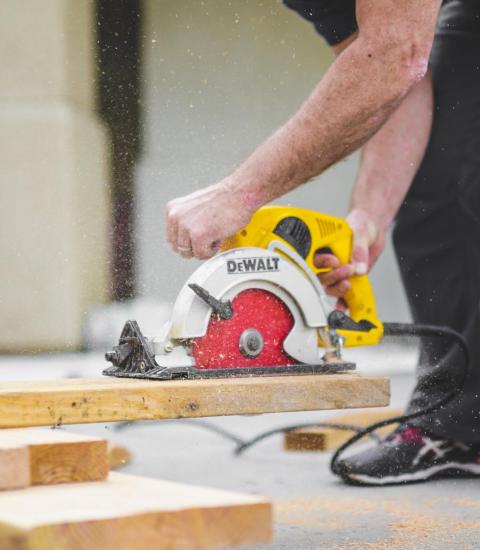
If you have been house bound due to COVID-19 social distancing restrictions, then you may have taken the opportunity to finally embark on neglected household jobs, such as tidying up the garden or do-it-yourself (DIY) projects around the home.
Do you wear eye protection while working on these home projects?
“Eye injuries won’t happen to me!” Don’t be so sure about it.
An article published in the BBC news1 in April 2020 reports that Oxford Eye Hospital doctors are treating an increased number of serious eye injuries since the onset of the COVID-19 lockdown. Many of the eye injuries are due to people not wearing eye protection when doing DIY jobs.
Eye injuries that occur at home is not a new phenomenon. Mansouri and co-authors (2007)2 describe 104 eyes injured at home. In each case the person had not been wearing eye protection at the time of the accident. Of those injured, 53% were men and 66% were under 30 years. Injuries include being struck with a blunt object (33% of injuries), being struck with a sharp object (30% of injuries) and injuries from chemicals (14% of injuries).
In another study, Bhogal and co-authors (2006)3 report 33 people who suffered a penetrating ocular injury. Half of the eye injuries occurred while gardening (for example, where a branch or thorn pierced the eye) or while doing DIY activities such as hammering, lawnmowing and using a nail gun. Penetrating ocular injuries are one of the most serious types of eye injuries and can contribute to a significant loss of vision. The researchers in this study report that eye protection was not worn by those who suffered the injuries.
Not all eye protectors are the same.
There are many different types of eye protectors, such as spectacles, face shields, goggles and visors. Eye protector products are tested against requirements listed in standards such as ANSI/ISEA Z87.1-20154 and AS/NZS 1336:20145. They are then given a rating according to the hazard that they protect against (e.g. fast travelling particles, chemicals, ultraviolet radiation).
It is important to wear the correct eye protector for the job. Otherwise you might not be getting adequate protection.
How do you work out what eye protector is appropriate?
There are several ways to determine which type of eye protector you need for the job. For example:
- Ask your eye care professional what type of eye protector you should wear. They can consult the appropriate standard in your country to determine what is recommended for the task.
- Contact the supplier of the equipment or chemicals that you are using to find out what eye protector the manufacturer recommends.
- Check for eye protector recommendations on the packaging of the equipment or chemicals you are using.
Eye protector packaging will also include information about what category of hazard it will protect against.
I wear prescription spectacles
Prescription spectacles do not provide the same level of protection as eye protectors. The frame and/or the lenses are generally not as strong, and they may break if an object strikes them. They also do not usually provide adequate lateral (side) protection to prevent objects reaching your eye from around the side of the spectacles, for example, tree branches might slip between the spectacle frame and your face while gardening, or chemical splashes may drip from your face into your eye.
Eye protection options for those who wear prescription spectacles include products that fit over the top of your spectacles and prescription eye protectors that are custom made for you6.
Your eyes are precious
Don’t be fooled into thinking that an eye injury can’t happen to you.
Eye protectors aren’t only for people in the workplace. They can protect you when you are doing work around the home too.
Do yourself, and your eyes a favour. Invest in the correct type of eye protector for jobs you are doing around the home.
It might just help you one day.
Jennifer Long works as a visual ergonomist in Australia. She helps businesses crate products and work environments that are comfortable for people’s eyes and allow them to see with ease. www.visualergonomics.com.au
References
- Coronavirus: Eye injuries increase ‘due to more DIY’. https://www.bbc.com/news/uk-england-oxfordshire-52260970
- Mansouri, MR, Mirshahi A, Hosseini M (2007) Domestic ocular injuries: A case series. European Journal of Ophthalmology 17(4): 654-659. https://journals.sagepub.com/doi/abs/10.1177/112067210701700427
- Bhogal G, Tomlins PJ, Murray PI (2006) Penetrating ocular injuries in the home. Journal of Public Health 29(1): 72-74. https://academic.oup.com/jpubhealth/article/29/1/72/1584816
- American National Standards Institute. ANSI/ISEA Z87.1-2015. American National Standard for Occupational and Educational Personal Eye and Face Protection Devices.
- Australian/New Zealand Standard AS/NZS 1336:2014. Eye and face protection – Guidelines.
- Long J (2007) What every ergonomist needs to know about…New choices for medium impact eye protection. Ergonomics Australia 21(3): 20-25. https://www.ergonomics.org.au/documents/item/227
